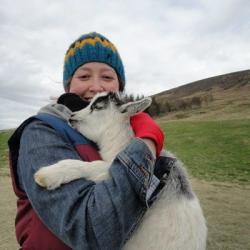Unnur Jökulsdóttir gathers first-hand accounts
During her childhood in Flói, a small rural area in Southwest Iceland, author Unnur Jökulsdóttir grew up with stories of the Hidden People. “My grandmother who was born and raised in the north had a great deal of affection for elves and Hidden People,” she writes in her book “Hefurðu séð huldufólk?’ (‘Have You Seen Hidden People?’). “On New Year’s nights, we’d sometimes stand together looking out the window, in the hopes of seeing the elves travelling. Sometimes, I stared so long out into the darkness that I thought I saw the sparkling hooves of the elf-horses and the glittering flight of the sleds that were loaded with their household goods as they moved house on New Year’s night.”
“Time passed,” she continues, “and I spent many years sailing around the world in a little sailboat and didn’t think much about Hidden People and elves. But when I traveled around Iceland for several years photographing and chatting with people for the book ‘Icelanders,’ I found it interesting how many people spoke about Hidden People and their goings-on as if they were discussing the kind of mundane and matter-of-fact events and people on the nightly news or neighbors from the next village.”
And so, in 2007, Unnur set forth on another trip around Iceland, asking people to share their experiences with the Hidden People. “I was quite surprised at how strongly this belief existed,” she remarked when I called to chat with her about the project. “How real it seemed. There was one old woman who often sees the Hidden People from her window, driving their cars really fast. They’ll be driving toward her house and then will turn suddenly and disappear into the cliffs. This is a normal, worldly woman—a respected country woman who would sit and talk politics with me. She said ‘I cannot help what I see—people can believe me if they want.’”
In another village along the south coast, Unnur met Lídó, a Filipino man who had moved to Iceland to help his daughter and her Icelandic husband run their travel company. “He actually saw Icelandic Hidden People,” she said. “There were beautiful cliffs at the edge of his family’s farm and the Hidden People came to him and asked him to build a fence around their home, a huge stone at the base of the cliff, because they were being disturbed by the tourists. So he did.”
Unnur noted that Lídó’s description of the Hidden People he spoke to matched up with other accounts she received of their appearance: they are said to look a lot like humans, though a bit more delicate. She notes that many accounts say that the Hidden People have no bridges on their noses, which can be a way for people to identify them.
It’s also interesting to note that none of the people who Unnur spoke with had trouble reconciling their belief in Hidden People with their religious beliefs or scientific training. One of her interview subjects was, in fact, a natural scientist who laughed and said that if some of his colleagues found it strange that he blended scientific practice with a study of the otherworldly or mysterious phenomena then “that’s their problem.”
Overall, Unnur said, Icelanders interpret these different beliefs “in their own ways” and are, as a rule, just rather open to all sorts of ideas. And while nearly all of the stories about people’s dealings with the Hidden People were positive ones, it also is maybe better to stay on their good side. “There was a poll conducted by the National Museum awhile ago—maybe 70% said that they didn’t want to deny the existence of Hidden People,” she laughed. “Maybe they are afraid to reckon with them. You never know what might happen.”
—
Unnur Jökulsdóttir co-authored two books with Þorbjörn Magnússon about the years they spent sailing around the world in a yacht they built themselves. She has also written a children’s novel, and, most recently, co-authored the best-seller “Icelanders,” a compilation of photographs and interviews of people all around the country. Her book “Hefurðu séð huldufólk?” (‘Have you seen hidden people?’) was published in 2007 and is currently available in Icelandic and German translation.
Buy subscriptions, t-shirts and more from our shop right here!
















